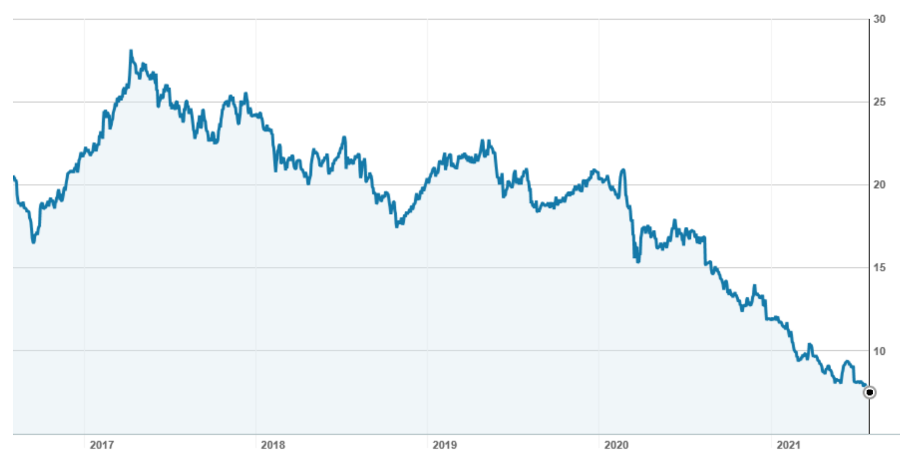They say that “every dog has its day” and that’s something AGL shareholders are hoping will prove to be true because AGL has been one of the “doggiest” stocks on the ASX. It is right up there in that “special” category with the likes of AMP. Since peaking just shy of $28 in April 2017, AGL has lost almost 75% closing on Friday at $7.23. It has been a one-way train down.
AGL – 7/16 to 7/21

AGL’s woeful performance is due to two main factors.
Firstly, it took on the Turnbull Government and the ACCC over its decision to close the Liddell coal fired power station in NSW. While the foreshadowed closure was bad enough, what really got the Government going was AGL’s refusal to consider a bid for the asset from one of its competitors. Under pressure from the public over energy prices, the Government (through the ACCC) embarked on a program to drive down wholesale energy prices.
Wholesale energy prices have fallen substantially, partly due to the proliferation of rooftop solar, but also through the development of other renewables. Demand also softened due to the impact of Covid-19. As Australia’s largest producer of baseload electricity principally through its Liddell, Bayswater, Loy Yang A and Torrens Island power stations, this has cruelled AGL’s earnings.
Secondly, the investor market has started to embrace ESG (environmental, social and governance) issues, and for many institutional fund managers, AGL is no longer on the “buy list”. Moreover, many institutions have acted to liquidate their positions in the stock.
The Board’s response has been to propose a split of the company into two independently listed companies – the “dirty” business of coal fired power stations (to be renamed Accel Energy) and the “clean” business of energy retailing and green power (to be named AGL Australia).
Accel Energy will be Australia’s largest electricity generator. In addition to the coal fired power stations (which in time will be transitioned into low-carbon industrial energy hubs), it will retain AGL’s existing portfolio of legacy wind farm purchase agreements and gas storage facilities. Focussing on large industrial customers, it will provide (under contract) a large proportion of AGL Australia’s electricity in the early years. It will also retain a 15% shareholding in AGL Australia.
The new AGL Australia will be Australia’s largest multi-product energy retailer, with 4.5m consumer and business customers. It will also have an energy portfolio of flexible generation and storage (gas fired peaking, hydro, solar and battery storage).
It will be carbon neutral for scope 1 and scope 2 emissions, with a clear pathway to carbon neutrality for all electricity supply. It will also own the 20% holding in Tilt Renewables.
In terms of earnings, the split between Accel and AGL Australia will be in the order of 60% for Accel and 40% for AGL Australia. Based on FY20 numbers, Accel’s EBITDA is around $1,500m and AGL Australia is around $900m (before the allocation of $300m corporate overhead).
The demerger will require shareholder approval and is timed to occur in the fourth quarter of FY22. Costs have yet to be determined.
The announcement of the demerger hasn’t done much to boost AGL’s share price. Rather, it has continued to head south, and this is despite a recent tick-up in wholesale electricity prices.
AGL is due to report its full year earnings on Thursday 12 August. Its latest guidance is for FY21 EBITDA to be in the lower half of its range of $1,585m to $1,845m (EBITDA in FY20 was $2,070m). For FY22, AGL has warned of a “material step-down in earnings” as a result of “the lower wholesale electricity prices of the past two years now being realised through forward sold positions, non-reoccurrence of one-off insurance proceeds and increases to wholesale gas supply costs”.
What do the brokers say?
According to FN Arena, each of the major brokers either has a ‘sell’ or ‘neutral’ rating on the stock (see table below). The consensus target price $7.82 is just 4.6% higher than the last ASX price.

While the brokers collectively assess the demerger as a “positive”, they are concerned about further earnings headwinds. For FY21, the brokers have AGL earning 85.3c per share, and for FY22, 57.1c per share. This puts AGL on a prospective PE (price/earnings) multiple of 8.8x for this year and for FY22, a multiple of 13.1x. On a payout ratio of 75%, the brokers’ forecast a dividend yield for FY22 of 5.7%.
My view
The risk with AGL is that there is no sign that the price has bottomed and it could still be a case of “catching a falling knife”. If some of the analysts are correct and there are further downgrades to earnings following AGL’s annual result, the current market price won’t look that attractive.
But on valuation, AGL looks cheap.
Further, I think that the demerger should be positive for the stock. As investors narrow in on this in coming months, it will be viewed as sound way to unlock value and at the same time dealing with the challenges and opportunities presented by the rapid evolution of renewables and decentralised energy technology, as well as changing customer and investor expectations.
AGL is long past a sell. I think it is in the ‘buy” zone for long term investors.
Important: This content has been prepared without taking account of the objectives, financial situation or needs of any particular individual. It does not constitute formal advice. Consider the appropriateness of the information in regard to your circumstances.